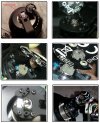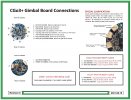Hello all!
CGO 3+ was working fine. (Typhoon H)
No crash, no firmware changes.
The Typhoon H starts up as usual.
The camera screams, one long (beeeeeeeeep), rotates wildly (at least two full rounds) then the gimbal goes limp.
The gimbal does not respond to the yaw control from the ST16. (ST16 Fully Calibrated)
I do have a good, clear image.
No gimbal control, at all.
If I touch the gimbal, the long (Beeeeep) returns for a moment and then stops.
The contact pins of the mounting plate are in good shape.
At this time, I can see no damaged wires.
Light on the front of the camera is red on start up and then turns green as normal.
I have searched through previous post and have found some information, just not my exact problem.
Has anyone else experienced this issue and if so, how was the issue corrected?
Thank you guys !!
CGO 3+ was working fine. (Typhoon H)
No crash, no firmware changes.
The Typhoon H starts up as usual.
The camera screams, one long (beeeeeeeeep), rotates wildly (at least two full rounds) then the gimbal goes limp.
The gimbal does not respond to the yaw control from the ST16. (ST16 Fully Calibrated)
I do have a good, clear image.
No gimbal control, at all.
If I touch the gimbal, the long (Beeeeep) returns for a moment and then stops.
The contact pins of the mounting plate are in good shape.
At this time, I can see no damaged wires.
Light on the front of the camera is red on start up and then turns green as normal.
I have searched through previous post and have found some information, just not my exact problem.
Has anyone else experienced this issue and if so, how was the issue corrected?
Thank you guys !!





![IMG_0969[1].JPG](/data/attachments/28/28056-a8de2fef9f0225e9df07311a9fa3c8c7.jpg?hash=qN4v758CJe)
![IMG_0970[1].JPG](/data/attachments/28/28057-e085ecec03bea8000c06cb3f48f40153.jpg?hash=4IXs7AO-qA)
![IMG_0971[1].JPG](/data/attachments/28/28058-205be0cbfb3cd7c9fd9a682cb181b6fe.jpg?hash=IFvgy_s818)
![IMG_0972[2].JPG](/data/attachments/28/28059-4c1f1b70416d223bc24bc767d5ddb837.jpg?hash=TB8bcEFtIj)